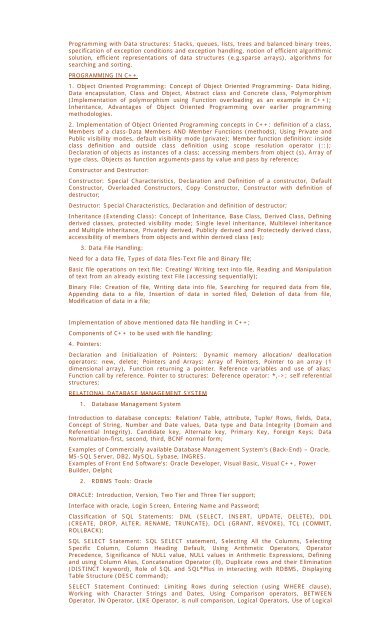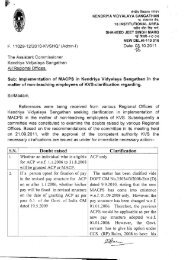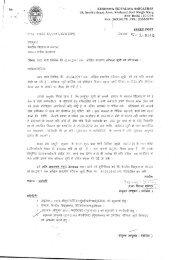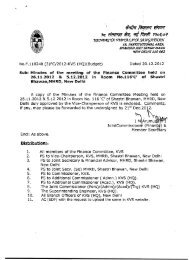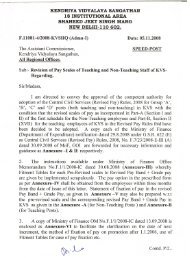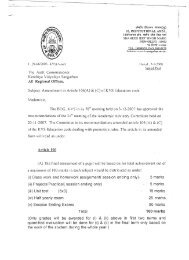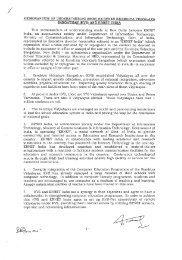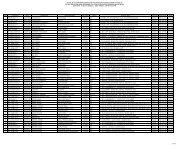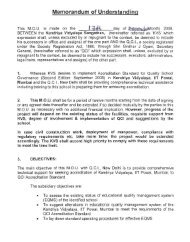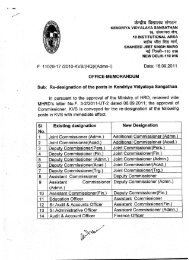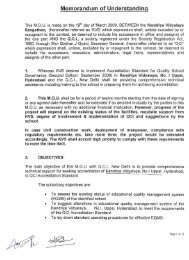Programming with Data structures: Stacks, queues, lists, trees and balanced binary trees,specification of exception conditions and exception handling, notion of efficient algorithmicsolution, efficient representations of data structures (e.g.sparse arrays), algorithms <strong>for</strong>searching and sorting.PROGRAMMING IN C++1. Object Oriented Programming: Concept of Object Oriented Programming- Data hiding,Data encapsulation, Class and Object, Abstract class and Concrete class, Polymorphism(Implementation of polymorphism using Function overloading as an example in C++);Inheritance, Advantages of Object Oriented Programming over earlier programmingmethodologies.2. Implementation of Object Oriented Programming concepts in C++: definition of a class,Members of a class-Data Members AND Member Functions (methods), Using Private andPublic visibility modes, default visibility mode (private); Member function definition: insideclass definition and outside class definition using scope resolution operator (::);Declaration of objects as instances of a class; accessing members from object (s), Array oftype class, Objects as function arguments-pass by value and pass by reference;Constructor and Destructor:Constructor: Special Characteristics, Declaration and Definition of a constructor, DefaultConstructor, Overloaded Constructors, Copy Constructor, Constructor with definition ofdestructor;Destructor: Special Characteristics, Declaration and definition of destructor;Inheritance (Extending Class): Concept of Inheritance, Base Class, Derived Class, Definingderived classes, protected visibility mode; Single level inheritance, Multilevel inheritanceand Multiple inheritance, Privately derived, Publicly derived and Protectedly derived class,accessibility of members from objects and within derived class (es);3. Data File Handling:Need <strong>for</strong> a data file, Types of data files-Text file and Binary file;Basic file operations on text file: Creating/ Writing text into file, Reading and Manipulationof text from an already existing text File (accessing sequentially);Binary File: Creation of file, Writing data into file, Searching <strong>for</strong> required data from file,Appending data to a file, Insertion of data in sorted filed, Deletion of data from file,Modification of data in a file;Implementation of above mentioned data file handling in C++;Components of C++ to be used with file handling:4. Pointers:Declaration and Initialization of Pointers: Dynamic memory allocation/ deallocationoperators: new, delete; Pointers and Arrays: Array of Pointers, Pointer to an array (1dimensional array), Function returning a pointer. Reference variables and use of alias;Function call by reference. Pointer to structures: Deference operator: *,->; self referentialstructures;RELATIONAL DATABASE MANAGEMENT SYSTEM1. Database Management SystemIntroduction to database concepts: Relation/ Table, attribute, Tuple/ Rows, fields, Data,Concept of String, Number and Date values, Data type and Data Integrity (Domain andReferential Integrity). Candidate key, Alternate key, Primary Key, Foreign Keys; DataNormalization-first, second, third, BCNF normal <strong>for</strong>m;Examples of Commercially available Database Management System’s (Back-End) – Oracle,MS-SQL Server, DB2, MySQL, Sybase, INGRES.Examples of Front End Software’s: Oracle Developer, Visual Basic, Visual C++, PowerBuilder, Delphi;2. RDBMS Tools: OracleORACLE: Introduction, Version, Two Tier and Three Tier support;Interface with oracle, Login Screen, Entering Name and Password;Classification of SQL Statements: DML (SELECT, INSERT, UPDATE, DELETE), DDL(CREATE, DROP, ALTER, RENAME, TRUNCATE), DCL (GRANT, REVOKE), TCL (COMMIT,ROLLBACK);SQL SELECT Statement: SQL SELECT statement, Selecting All the Columns, SelectingSpecific Column, Column Heading Default, Using Arithmetic Operators, OperatorPrecedence, Significance of NULL value, NULL values in Arithmetic Expressions, Definingand using Column Alias, Concatenation Operator (ll), Duplicate rows and their Elimination(DISTINCT keyword), Role of SQL and SQL*Plus in interacting with RDBMS, DisplayingTable Structure (DESC command);SELECT Statement Continued: Limiting Rows during selection (using WHERE clause),Working with Character Strings and Dates, Using Comparison operators, BETWEENOperator, IN Operator, LIKE Operator, is null comparison, Logical Operators, Use of Logical
Operators (AND/OR/NOT Operators), Logical Operator Precedence, ORDER BY Clause,Sorting in Ascending/Descending Order, Sorting By Column Alias Name, Sorting Onmultiple Columns;Functions: SQL Functions, Types of SQL Function (Single Row/ Multiple Row), Single RowSQL Functions, Character Functions (Case Conversion/ Character Manipulation), CaseConversion Functions [lower (), InitCap (), UPPER ()] Character Manipulation Function[CONCAT (), INSTR (), LENGTH (), TRIM (), SUBSTR (), LPAD () ], Number Functions(ROUND (), TRUNC (), MOD() ), Working with Dates [LAST_DAY(), MONTHS_BETWEEN(),NEXT_DAY(), ADD_MONTHS(), ROUND(), TRUNC() ] Arithmetic Operation on Dates, DateFunctions and their Usage, Data type Conversion Functions, Implicit and ExplicitConversion, TO_CHAR Function with Dates, TO_CHAR Function For Numbers, TO_NUMBERand TO_DATE Functions, NVL Function and its Usage, DECODE Function and its Usage;Grouping Records: Concept of Grouping Records and Nested Grouping, Nested Grouping ofrecords, Group Functions, Types of group functions [MAX (), MIN (), AVG (), SUM (),COUNT ()], using AVG and SUM Functions, Using MIN and MAX Functions, Using theCOUNT Function, using COUNT(*), DISTINCT clause with Count, Group Functions and NullValues, Using NVL Function with Group Functions, Grouping Records: Group By Clause,Grouping By More than One Column, Illegal Queries with Group By Clause, ExcludingGroup Results: Having Clause, Nesting Group Functions.Sub Queries: Concept of Sub-Query, Sub Query to solve a Problem, Guidelines <strong>for</strong> UsingSub Queries, Types of Sub-Queries (Single Row and Multiple Row) and (Single Column andMultiple Column); Single Row Sub-Query and its Execution;Displaying Data From Multiple Tables: Concept of Join, Result of Join, Cartesian Productand Generating Cartesian Production example using Mathematical Set), Types of Joins(EQUL, SELF, NON-EQUI, OUTER (LEFT and RIGHT)), Equi-join, Additional SearchConditions using AND operator, Short Naming Convention <strong>for</strong> Tables (Table Aliases), Non-Equi join and its Implementation, Outer-Join and Its Usage, Self-Join (Joining a table toItself);Manipulating Data of A Table /Relation: Concept of DML (Data Manipulation Language),INSERT Statement, Inserting New Rows, Inserting New Rows, with Null Values, InsertingDate Values, Use OF substitution Variable to Insert Values, Copying Rows From AnotherTable, Update Statement to Change Existing Data of a Table, Updating Rows In A Table,Updating Rows Based on Another Table, Delete statement/ Removing Row/ Rows from aTable, Deleting, Rows Based on condition from another Table; Making Data ManipulationPermanent (COMMIT). Undo Data Manipulation Changes (ROLLBACK)Database Objects: View, Table, Sequence, Index, and Synonyms, DDL (Data DefinitionLanguage), Naming Convention, Creating Views, Creating Synonyms, Simple Views andComplex Views, Retrieving Data From a View, Querying a View, Modifying a view.Including Constraints: Constraints, Concept of using Constraints, Constraint Guidelines,Defining Constraints, NOT NULL, UNIQUE KEY, PRIMARY KEY, FOREIGN KEY, FOREIGN KEYConstraint Keywords, CHECK, Adding a constraint, Dropping a Constraint, DisablingConstraints, Enabling Constraints, Viewing Constraints, Viewing The Columns, Associatedwith Constraints;Creation of a Table/ Relation: CREATE TABLE Statement, Data types, the DEFAULT option,Creating Tables, Referencing Another User’s Tables, Querying the Database Dictionary toview all tables in the Oracle Database, Creating a Table by Using a Sub-Query;Managing Existing Tables and other Database Objects: The ALTER TABLE Statement,Adding a New Column in a Table, Modifying Existing Column, Dropping a Column,Renaming an Object, Truncating a Table, Adding Comments to a Table, Dropping Views,Dropping Synonyms, Dropping Tables; giving permission to other users to work onCreated Tables and Revoking it (GRANT and REVOKE statement).BUSINESS COMPUTINGGeneral concept, User interfaces (front End), Underlying Database (back End), Integrationof User Interface and Database;More application areas of Databases:Inventory control, Financial Accounting, Pay-Accounting System, Invoicing ManagementSystem, Personal Management System/ hard system, Fees Management System, ResultAnalysis System, Admission Management System, Income Tax Management System;Advance Program Development Methodology: System Development Life Cycle, RelationalDatabase Concept, Relational Database, Management System, Data Models (EntityRelationship Model), Entity and Entity Set, Attributes (Single, Composite and Multi-Valued), Relationship (One-to-One, One-to-Many and Many-to-Many), Entity RelationshipModeling Conventions, Communicating with an RDBMS using SQL, Relational DatabaseManagement System, SQL Statements, About programming language in SQL.Data Dictionary, Data Warehousing, Data Mining, Meta Data;Object Modeling: Introduction to object oriented modeling using Unified ModelingLanguage (Concepts only).Client Server Computing: Concept of Client Server Computing.WEB DEVELOPMENT


